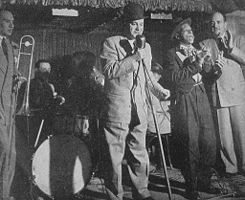Sharkey Bonano
| Sharkey Bonano | |
|---|---|

Sharkey (center at microphone) and band in New Orleans, 1950. Photo by Stanley Kubrick
|
|
| Background information | |
| Birth name | Joseph Gustaf Bonano |
| Also known as | Sharkey Banana Sharkey Bananas |
| Born |
April 9, 1904 New Orleans, Louisiana, U.S. |
| Died |
March 27, 1972 (aged 67) New Orleans, |
| Genres | Jazz |
| Occupation(s) | Musician, singer |
| Instruments | Trumpet, vocals |
Joseph Gustaf "Sharkey" Bonano (April 9, 1904 – March 27, 1972), also known as Sharkey Banana or Sharkey Bananas, was a jazz trumpeter, band leader, and vocalist.
Bonano was known for playing searing hot and technically virtuoso trumpet with a beautiful tone. His musical abilities were sometimes overlooked in part because of his love of being an entertainer; he would often sing silly lyrics in a high raspy voice and break into dance routines on stage.
Bonano was born in the Milneburg neighborhood of New Orleans, Louisiana, by the shores of Lake Pontchartrain. He was a well regarded professional player by his mid teens, in his youth mostly playing in New Orleans other than a period with Eddie Edwards' band in New York City in 1920. Bonano then started traveling widely, seldom staying in one place or with one band for more than a few months. He briefly replaced Bix Beiderbecke in the Wolverines Orchestra, and Nick LaRocca in the Original Dixieland Jazz Band. Sharkey first recorded in New Orleans with Norman Brownlee's band in 1925, and soon after had a band under his own name. He returned to New York for work in Jimmie Durante's band, then with the Jean Goldkette Orchestra in 1927, returned to his home town to play with Leon Prima, to Los Angeles, California to work with Larry Shields. After time back in New Orleans played with the Ben Pollack Orchestra in 1936. After leaving Pollack's band he led his own band on 52nd Street in New York for three years. After World War II he toured Europe, Asia, and South America, played residencies in Chicago and New York, and then was a regular on Bourbon Street in the New Orleans French Quarter. In 1949, he appeared at the Roosevelt Hotel's Blue Room as well as the Famous Door Bar.
...
Wikipedia
